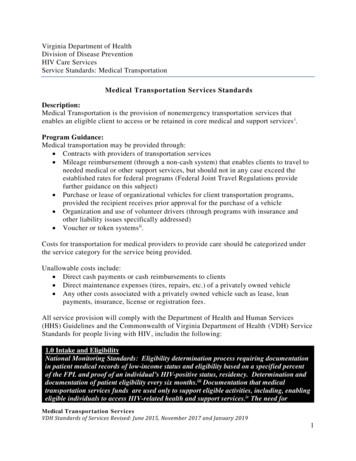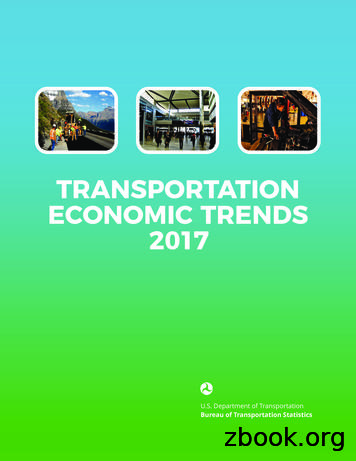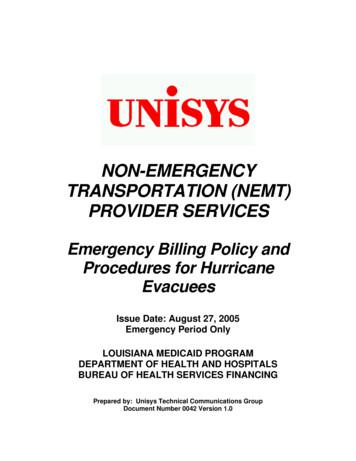Washington State University Transportation Services At A Glance
Washington State UniversityTransportation Services At a GlanceThe following is information regarding finances, facilities, enforcement and staffing.If you have any questions or would like additional details, please contact us attransportation@wsu.edu.
Budget“Why do I have to pay for parking?”WSU Transportation Services is a self-supported auxiliary and does not receive federal,state, grant or tuition funding. Revenue for capital projects, maintenance, andoperations comes solely from parking fees and fines.Financial - FY 2019 Revenue 65,440 555,613 562,351 2,717,887 1,371,901Parking PermitsShort-term ParkingParking FinesOther RevenueSpecial Event Parking
Financial - FY 2019 Operating & Maintenance Expenses 276,542 425,356 1,566,240 454,798 536,109Wages, Salaries & BenefitsGoods and ServicesGeneral MaintenanceAlternative TransportationSnow Removal & Cleanup
Financial - FY 2019 Other Expenses 114,208 220,000 989,450 491,452 619,992Debt ServiceDepreciation ExpenseAdministrative Service ChargeTransfersCapital Projects
Transportation Unit CostsConstruction cost per garage space 27K/ 76KConstruction cost per paved space 12KConstruction cost per gravel space 8KCost per operating hour of transit 110Annual cost per space for garage structural maintenance 150Annual cost per space for paved surface maintenance 25FacilitiesThe following table contains information regarding parking facility space counts.Parking Space TypeNumber of SpacesSurface Parking (permit)6274Meter/Garage Hourly435Garage Parking (permit)463Disability302Motorcycle92Electric Vehicle Stations6Other *771Total8343* Includes Park and Ride, Reserved, Loading, Service andMiscellaneous SpacesStaffingTransportation Services currently employs 18 full-time and as many as 65 part-timestudent employees. Student employees are hired for various positions including, frontoffice clericals, cashiers, field operations and event staff.WSU Transportation Services is a Lean management practitioner, whose “True North”is to “Optimize Value of the Transportation System Assets and Resources”
EnforcementWSU Transportation Services uses parking enforcement as a management tool toensure our customers have a reliable parking space when they come to campus. Only10.69% of revenue comes from parking fines. The WSU parking and transportationsystem largely supports itself through proactive fees such as permits, hourly garageand meter rates rather than reactive parking fines.YearFY 2012FY 2013FY 2014FY 2015FY 2016FY 2017FY 2018FY 2019Total Citations(Warnings 4115,72617,068Citation Issuance Trends25,00020,00015,00010,0005,0000FY 2015FY 2016FY 2017Total Citations (Warnings and Citations)FY 2018WarningsCitationsFY 2019
University Parking and Transportation Task ForceFY 2018NameHongda RenCraig ColeKen CasavantVacantAlec SolemslieBill GardnerSavannah RogersAli HajbabaieBailey FillingerLana RedmanCyndi ArbourJohn ShaheenEric SlocumDean LuethiEric NeedhamRepresentingGraduate and Professional Student AssociationAdministrative and Professional Advisory CouncilFacultyParking Appeals Committee ChairResidence Hall AssociationAssoc. VP Finance and AdministrationAssociated Students, WSUFacultyCommuter StudentsFinance and AdministrationFacilities Services CapitalTransportation ServicesFacilities Services -- OperationsFaculty SenateWashington Federation of State Employees
Transportation Services currently employs 18 full-time and as many as 65 part-time student employees. Student employees are hired for various positions including, front office clericals, cashiers, field operations and event staff. WSU Transportation Services is a Lean management practitioner, whose "True North"
Transportation Services Direct Transportation Providers deliver non-emergency transportation services that enable an eligible client to access or be retained in core medical and support services. Clients are provided with information on transportation services and instructions on how to access the services. General transportation procedures:
2.7 CATS Survey of Transportation Services in Mecklenburg County A community transportation survey was also designed and used in 2008 to develop an inventory of transportation services in the county, identify perspectives about transportation needs, and capture interest in transportation coordination. The survey was sent to approximately 500
Transportation Engineering The transportation engineering faculty offer graduate course in transportation planning, design, operations and safety with an emphasis on surface transportation. The faculty are engaged in research in transportation planning and safety, intelligent transportation systems, transportation systems analysis, traffic flow .
fee basis. Airlines, railroads, transit agencies, common carrier trucking companies, and pipelines are examples of for-hire transportation. Other types of transportation are discussed in Chapter 2. Box 1-1: Transportation Services Index The Bureau of Transportation Statistics’ (BTS) Transportation Services Index (TSI) measures the
Directly providing transportation services based on the needs of the community, geography, and funding. Most transportation services are round-trip and provide transportation to the health center or social services from a patient's home or work site. TRANSPORTATION SERVICES Point of care is the timely delivery of health care products and
Transportation for Nursing Home Residents, and, Transportation for rehabilitation services unless the rehabilitation services have been authorized by the Prior Authorization Unit . Note: Transportation for the initial visit for an evaluation for the need of rehabilitation services will be approved by the Transportation Dispatch Office.
Washington State Farmers Market Manual The Washington State Farmers Market Manual is a publication of the Washington State Department of Agriculture Small Farm and Direct Marketing Program, the Washington State University Sma
Transportation's contribution to the economy can be measured by its contribution to gross domestic product (GDP). GDP is an economic measure of all goods and services produced . Source: U.S. Department of Transportation, Bureau of Transportation Statistics, 2017. Transportation-Related Final Demand by GDP Component Figure 2-1 shows total .






















